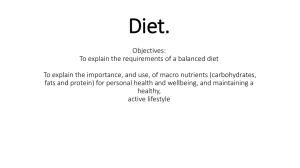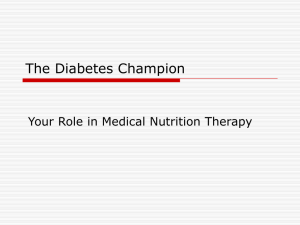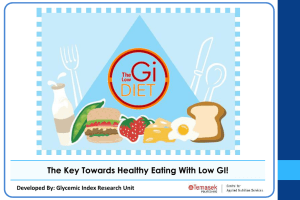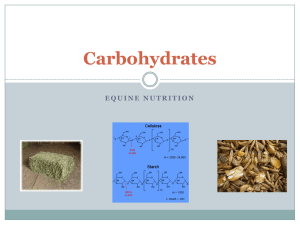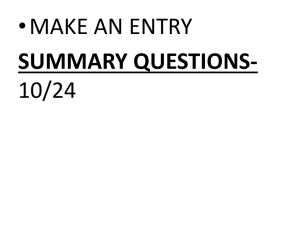What Is the Glycemic Load?
advertisement
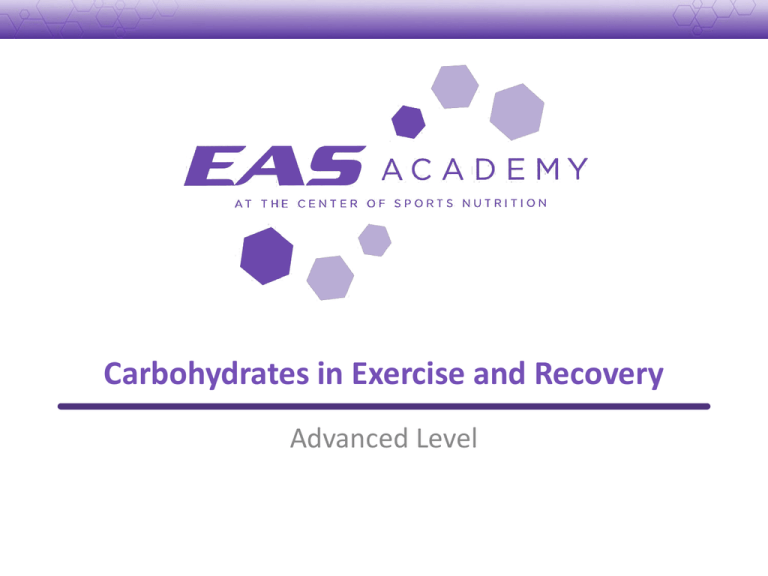
Carbohydrates in Exercise and Recovery Advanced Level Module II Properties of Carbohydrates: Considerations for Sports Performance Carbohydrates and Performance General Recommendations for Carbohydrate Intake During Exercise Properties of Carbohydrates: Considerations for Sports Performance What Is the Glycemic Index? System of ranking foods according to how much they raise blood glucose relative to a reference food – Developed by Jenkins DJ, et al. Am J Clin Nutr. 1981;34(3):362-366. Rapidly digested or absorbed carbohydrates = high GI Slowly digested or absorbed carbohydrates = low GI References on GI – Brand-Miller J, et al. The New Glucose Revolution. 3rd ed. New York, NY: Marlowe & Co.; 2006 • Written by experts on GI – Atkinson, et al. Diabetes Care. 2008;31(12):2281-2283 • Most comprehensive table of the GI of foods that has been assembled to date Abbreviations: GI, glycemic index. Figure from http://www.glycemicindex.com/aboutGI.htm. 4 What Does the Glycemic Index Value Mean? The glycemic index (GI) is expressed as a ratio comparing the blood glucose increase caused by a test food to that of a reference food (usually glucose [G], historically white bread [WB]) for 2 hours following ingestion: Area Under the Curve for Test Food × 100 = GI Area Under the Curve for Reference Food Conversion for different reference foods: GIG × 1.4 = GIWB – The GIG for carrots (mean of 4 studies) = 47 – The GIWB for carrots (mean of 4 studies) = 68 Atkinson FS, et al. Diabetes Care. 2008;31(12):2281-2283. 5 What Is the Glycemic Load? The glycemic load (GL) takes into account the amount of carbohydrate (CHO) in a common serving in addition to its glycemic index (GI): GL = (GI of CHO × grams of CHO per serving) ÷ 100 Example: – Carrots (peeled, boiled) have a GI of 47 and 5 g CHO per serving The GLG of carrots is: (47 × 5) ÷ 100 = 2.4 Abbreviations: CHO, carbohydrate; GL, glycemic load; GI, glycemic index. Atkinson FS, et al. Diabetes Care. 2008;31(12):2281-2283. 6 Glycemic Index and Load Standards for Foods GI (based on glucose reference) – Low GI – Intermediate GI – High GI 0 to 55 56 to 69 ≥ 70 GL (based on glucose reference) – Low GL – Intermediate GL – High GL 0 to 10 11 to 19 ≥ 20 Abbreviations: GI, glycemic index; GL, glycemic load. Brand-Miller J, et al. The New Glucose Revolution: The Authoritative Guide to the Glycemic Index-The Dietary Solution for Lifelong Health. 3rd ed. New York, NY: Marlowe and Co.; 2006. Brand-Miller JC, et al. Am J Clin Nutr. 2003;77(4):993-995. 7 Usefulness of Glycemic Index and Glycemic Load Diabetes control with low GI foods and diets – Supplement to exchange lists – Category B evidence according to ADA – Positive meta-analysis • Brand-Miller J, et al. Diabetes Care. 2003;26:2261-2267 Sports nutrition (pre- and postexercise)1 – Low-GI foods before endurance exercise (shaky evidence) – High-GI foods after exercise (strong evidence of benefit) Reduced CVD risk with low GI/low GL2 – Mostly epidemiologic evidence Weight control with low GI/low GL3 Lowered risk of several types of cancer with low GI/low GL4,5 – Mostly epidemiologic evidence Abbreviations: ADA; American Diabetes Association; CVD, cardiovascular disease; GI, glycemic index; GL, glycemic load. 1. Burke LM, et al. Int J Sport Nutr. 1998;8(4):401-415. 2. Brand-Miller J, et al. J Am Coll Nutr. 2009;28(suppl):446S-449S. 3. Ludwig DS. Lipids. 2003;38(2):117-121. 4. Freedland SJ, et al. Curr Opin Urol. 2009;19(3):263-267. 5. Gnagnarella P, et al. Am J Clin Nutr. 2008 ;87(6):1793-1801. 8 Blood Glucose Response to High vs Low Glycemic Index Foods Data on blood glucose responses to bread and lentils in a subject without diabetes Blood Glucose, mmol/L 7 Lentils 6 Bread 5 4 3 2 1 0 0 15 30 45 60 75 Time, minutes 90 105 120 Wolever TM, et al. Am J Clin Nutr. 1991;54(5):846-854. 9 Blood Glucose Response to Foods With Varying Glycemic Index Blood Glucose Areas Under the Curve for the 4 Meals (mmol•min/L) 7 White bread Candy bar Moderate-carbohydrate energy bar High-carbohydrate energy bar Blood Glucose, mmol/L 6.5 6 5.5 5 4.5 4 3.5 0 White Bread 166.1 ± 31.7 15 30 Candy Bar 161.6 ± 19.4 45 60 75 Time, minutes Moderate-Carbohydrate Energy Bar 91.9 ± 22.6 90 105 120 High-Carbohydrate Energy Bar 125.0 ± 21.6 Hertzler SR. J Am Diet Assoc. 2000;100(1):97-100. 10 Slowly and Fully Digested Carbohydrates (Low GI) Isomaltulose1 – Glucose and fructose linked by an alpha-1,6 bond – Results in a more steady and sustained release of glucose into the blood compared with sucrose – Occurs naturally in honey, but can be synthesized from sucrose Sucromalt2 – Produced by enzymatic conversion of sucrose and maltose into a fructose and oligosaccharide syrup • Oligosaccharide is made of glucoses linked by alternating alpha-1,3 and alpha-1,6 linkages – Digestion profile similar to isomaltulose Gamma-cyclodextrin3 – Ring of 8 glucose molecules Abbreviations: CHO, carbohydrate; GI, glycemic index. 1. Lina BA, et al. Food Chem Toxicol. 2002;40(10):1375-1381. 2. Xtend™ Sucromalt. Cargill, Inc. Available at: http://www.cargill.com/food/na/en/products/sweeteners/specialty-sweeteners/xtend-sucromalt/index.jsp. Accessed February 24, 2011. 3. Munro IC, et al. Regul Toxicol Pharmacol. 2004;39:S3-13. 11 Glycemic Response to Slowly Digested Carbohydrates Glycemic response to 50 g sucromalt 9 8 7 6 5 4 3 2 1 0 b a c d e f 0 15 30 45 60 90 120 150 180 Time Postprandial, minutes1 Blood Glucose, mmol/L Plasma Glucose, mmol/L Glycemic response to 50 g maltodextrin Glycemic response to 50 g glucose Glycemic response to 50 g isomaltulose Glycemic response to 50 g high-fructose corn syrup Glycemic response to 50 g sucrose 9 Blood Glucose, mmol/L Glycemic response to 50 g gamma-cyclodextrin 7 7 6 bc abc 5 4 bc ** * * 5 abc ac ab ** * 3 0 30 60 90 Time, minutes2 120 0 30 60 90 120 150 180 Time, minutes3 Letters denote statistical differences. 1. Reprinted from Asp ML, et al. J Am Coll Nutr. 2006;25(1):49-55. 2. Grysman A, et al. Eur J Clin Nutr. 2008;62:1364-1373. 3. Reprinted from Holub I, et al. Br J Nutr. 2010;103(12):1730-1737. 12 Glycemic Index and Sports Nutrition Pre-exercise (1 to 2 hours): – Low-GI foods for endurance – Alters substrate utilization ( free fatty acids, more stable glucose, insulin) – No consistent effects on performance observed, despite above • How is performance measured? – Time to exhaustion vs time trial • Carbohydrate intake during exercise eliminates need for low GI pre-exercise Postexercise: – High-GI foods and high insulin response increase rate of muscle glycogen synthesis Abbreviation: GI, glycemic index. Burke LM, et al. Int J Sport Nutr. 1998;8(4):401-415. 13 Plasma Glucose Response to Energy Gels (N = 15) Bores J. “The glycemic index of energy gels in normal volunteers” [honors thesis]. The Ohio State University. 2003. 14 Key Methodologic Issues for Glycemic Index Time of sampling – 2 hours after start of test meal (non-diabetes) • 0, 15, 30, 45, 60, 90, and 120 minutes – 3 hours after start of test meal (diabetes) Standardized amount of carbohydrate (50 g available carbohydrate, usually) Method of blood glucose sampling – Capillary finger stick or arterial blood more sensitive than venous blood Method of calculating area under the curve (AUC) – Positive incremental AUC vs total or net AUC Brouns F, et al. Nutr Res Rev. 2005;18(1):145-171. 15 Other Methodologic Issues for Glycemic Index Choice of reference food (glucose vs white bread) Number of repetitions with reference and test foods How the food GI is calculated – Should calculate AUC of test and reference foods and the GI for each individual subject – Use the mean of the individual GIs as the GI for the food – Do not calculate the GI based on the mean AUCs for test and reference foods Abbreviations: AUC, area under the curve; GI, glycemic index. Brouns F, et al. Nutr Res Rev. 2005;18(1):145-171. 16 Carbohydrates and Performance Carbohydrate and Fat Use at Different Exercise Intensities As the intensity of exercise increases, muscle glycogen constitues a greater portion of the energy source (Weightlifting, sprinting, etc) Energy Expended, cal/kg/min 300 (Soccer, dancing, etc) Muscle glycogen 200 Muscle triglyceride 100 0 (Leisurely walking, slow cycling) Plasma FFA Plasma glucose 25 65 85 Maximal Oxygen Consumption, % Abbreviation: FFA, free fatty acid. Reprinted from Coyle EF. Am J Clin Nutr. 1995;61(suppl):968S-979S. 18 Fuel Substrates Used Over the Course of Exercise Energy Expenditure, % 100 Muscle triglycerides 90 80 70 Plasma free fatty acids 60 50 40 Blood glucose 30 20 Muscle glycogen 10 0 0 1 2 3 4 Exercise Time, hours Reprinted from Coyle EF. Am J Clin Nutr. 1995;61(suppl):968S-979S. 19 High-Carbohydrate Diet and Time to Exhaustion 200 Time to Exhaustion, min 180 160 140 120 100 80 60 40 20 0 Mixed Diet Protein and Fat Diet High-Carbohydrate Diet Subjects (n = 9) cycled to exhaustion before diets Diets were fed for 3 days: – Mixed diet (self selected) – Protein and fat diet (2,800 kcal, 46% fat, 54% protein) – High-carbohydrate diet (2,800 kcal, 82% carbohydrate, 18% protein) Subjects cycled to exhaustion at end of each diet Bergström J, et al. Acta Physiol Scand. 1967;71(2):140-150. 20 Effect of High- vs Moderate-Carbohydrate Diet on Muscle Glycogen and Rowing Power Glycogen Female and Male 100 LO CHO 90 HI CHO 80 70 60 50 40 30 20 10 0 –10 1 2 3 Weeks of Training Average Power, watts, % change from day 1 High CHO diet provided increased muscle glycogen reserves and power output compared with a moderate CHO diet in rowers 4 Female and Male 18 LO CHO 14 HI CHO 12 10 8 6 4 2 0 –2 –4 1 2 3 Weeks of Training 4 Diets were either 5 or 10 g CHO per kg body weight for training period duration – (55 kg individual: 275 for low, 550 g for high) – (75 kg individual: 375 for low, 750 g for high) Muscle glycogen (vastus lateralis) and average rowing power output were measured in members of a collegiate rowing team Abbreviation: CHO, carbohydrate. Simonsen JC, et al. J Appl Physiol. 1991:70(4):1500-1505. 21 Effect of High- vs Moderate-Carbohydrate Diet on Running Endurance (70% VO2max) Two runs spaced 22.5 hours apart CHO intake of control group (blue): T1 – 5.8 g/kg/day during recovery CHO intake of high-CHO group (red): T2 – 8.8 g/kg/day during recovery 0 20 40 60 Run Time, min 80 100 Abbreviation: CHO, carbohydrate; VO2max, maximal oxygen consumption. Fallowfield JL, et al. Int J Sport Nutr Exerc Metab. 1993(2):3:150-164. 22 Carbohydrate Loading Traditional protocol – Depletion of glycogen stores (~ Days 6 to 3 before event) • Low-carbohydrate diet and hard exercise – Supercompensation of muscle glycogen (~ Day 3 before event to day of event) • Very high-carbohydrate diet (8 to 12 g/kg body weight/day) and tapering of exercise Cons – Depletion phase is hard on the body and difficult to tolerate in training • May lead to headaches, irritability, and increased risk of injury 23 Is the Strict Carbohydrate-Loading Protocol Necessary? Depletion phase was not needed to influence glycogen storage (Group A vs B) Performance on 20.9-km run was not affected Pre-run Muscle Glycogen Level, mmol glucosyl/kg wet tissue – Run was probably too short for muscle glycogen to be the limiting factor Group A, 3 days on 15% CHO, 3 days on 70% CHO Group B, 3 days on 50% CHO, 3 days on 70% CHO Group C, 6 days on 50% CHO Depletion-tapered training in all groups followed by a 20.9-km run (~13 miles). Abbreviation: CHO, carbohydrate. Sherman WM, et al. Int J Sports Med. 1981;2(2):114-118. 24 Carbohydrate Ingestion During Exercise Having high glycogen stores is very important to prolonging endurance – Related to diet and exercise in the days and hours before event – Endogenous carbohydrate oxidation at high intensity – Especially important for events longer than 90 to 120 minutes (eg, marathons and cycling events) What is the role of exogenous (ingested) carbohydrate oxidation? – Can exogenous carbohydrate spare glycogen stores (liver and or muscle)? – Can dietary carbohydrate have other effects (central nervous system)? 25 Evidence for Efficacy of Carbohydrates Consumed During Exercise Jeukendrup (2004) reviewed multiple studies (n = 22) of walking, running, and cycling in which carbohydrates were given during exercise – 23 of 36 observations within these studies showed a positive effect of carbohydrate on endurance – Effective dose • Minimum, 16 to 22 g carbohydrate/hour • Maximum, 75 g carbohydrate/hour – No studies showed an adverse, or ergolytic, effect of carbohydrate on performance – Form of carbohydrate (solid or liquid) was of little significance, although the vast majority of the studies used a beverage Jeukendrup AE. Nutrition. 2004;20(7-8):669-677. 26 Use of Multiple Transportable Carbohydrates Oxidation of any single type of carbohydrate during exercise is limited to 1 g/min or less Limiting factor is the ability of the intestine to absorb the carbohydrate – Saturation of intestinal sugar transporters is key Giving carbohydrates that are absorbed by different intestinal sugar transporters can – Help to bypass, to some degree, the limited intestinal absorption of carbohydrate – Increase exogenous carbohydrate oxidation during exercise to 1.2-1.5 g/min Probably only important in long-duration and very-intense physical efforts such as full triathlons (eg, Ironman) or cycling races such as the Tour de France Jeukendrup AE. Nutrition. 2004;20(7-8):669-677. 27 Effects of Multiple Transportable Carbohydrates on Exogenous Carbohydrate Oxidation Carbohydrates using different transporters Exogenous Carbohydrate Oxidation, g/min 100% exogenous carbohydrate oxidation Single carbohydrates 2.0 Average observed rate 1.0 0 0 1.0 2.0 3.0 Carbohydrate Ingestion Rate, g/min 4.0 Jeukendrup AE. Nutrition. 2004;20(7-8):669-677. 28 General Recommendations for Carbohydrate Intake During Exercise Carbohydrates as Energy at Different Times Carbohydrate consumed in the days before event – Used to provide adequate glycogen stores in muscle • Prevent “hitting the wall” Carbohydrate consumed in the hours before the event – Used to preserve liver glycogen stores, which can deplete after approximately 8 to 12 hours of fasting Carbohydrate consumed during event – Used to maintain blood glucose, especially when liver glycogen is depleted United States Anti-doping Agency. Optimal dietary intake guide. Available at: http://www.usada.org/diet/?gclid=COOM-Ky95aYCFQTNKgodzVQL2w. Accessed January 31, 2011. Ensminger A. Foods and Nutrition Encyclopedia 2nd Edition Volume 1. Boca Raton, FL: CRC Press LLC; 1994. Pages 1202-1203. Burke L. Practical Sports Nutrition. Champaign, IL: Human Kinetics; 2007. Page 124. Clark N. Sports Nutrition Guidebook 4th Edition. Champaign, IL: Human Kinetics; 2008. Page 119. 30 Carbohydrates and Sports Nutrition Important for maximizing muscle glycogen stores – Depleted muscle glycogen—“Hitting the wall” – Depleted liver glycogen—“Bonking” Training and high-carbohydrate diets maximize glycogen stores Carbohydrates also important during recovery from exercise – Put back glycogen as quickly as possible – Glycogen synthesis is maximal within 2 hours after exercise United States Anti-doping Agency. Optimal dietary intake guide. Available at: http://www.usada.org/diet/?gclid=COOM-Ky95aYCFQTNKgodzVQL2w. Accessed January 31, 2011. Ensminger A. Foods and Nutrition Encyclopedia 2nd Edition Volume 1. Boca Raton, FL: CRC Press LLC; 1994. p 1202-1203. Burke L. Practical Sports Nutrition. Champaign, IL: Human Kinetics; 2007. p 124. Clark N. Sports Nutrition Guidebook 4th Edition. Champaign, IL: Human Kinetics; 2008. p 119. Ivy JL, et al. J Appl Physiol. 1988;64(4):1480-1485. 31 Carbohydrates Before Exercise Intake of up to 10 g/kg per day in days before event – Increases muscle glycogen – Increases endurance in events lasting > 90 minutes Intermittent, high-intensity exercise performance may also be increased Carbohydrate loading – No need for depletion phases common in older protocols – Focus now on a high-carbohydrate diet with tapered exercise – Men and women increase glycogen stores equally well on high-carbohydrate diet • Assuming energy and carbohydrate intake is sufficient Burke LM, et al. J Sport Sci. 2004;22(1):15-30. 32 Recommendations Regarding Carbohydrate Loading Day 7 before event – Taper exercise Days 6 to 4 before event – Taper exercise – Moderate-carbohydrate mixed diet (5 to 7 g CHO/kg body weight/day) Days 3 to 1 before event – Taper exercise and/or increase rest – High-carbohydrate diet (8 to 12 g CHO/kg body weight/day) Abbreviation: CHO, carbohydrate. Williams MH. Nutrition for Health, Fitness and Sport. 9th ed. New York, NY; McGraw Hill; 2009. 33 Carbohydrates Immediately Before Exercise 200 to 300 g CHO consumed after overnight fasting and 2 to 4 hours before exercise improves performance Ingestion of CHO 1 hour before exercise does not usually impair performance – Depends on individual tolerance GI of pre-event CHO – Low-GI CHO improves metabolic profile for endurance exercise • Effect on performance is questionable • Exercise itself helps blunt the insulin response – Effect of GI is largely obliterated if CHO is consumed during exercise1 Abbreviations: CHO, carbohydrate; GI, glycemic index. 1. Burke LM, et al. J Appl Physiol. 1998;85:2220-2226. 34 Pre-Competition Meal One of the most variable aspects of the athlete’s diet – – – – Depends on individual tolerance Athletes often have certain beliefs about food’s effect on performance Ranges from no food to the old “steak and eggs” breakfast Depends on the sport to some degree Functions of the pre-event meal – – – – Prevent dehydration Maintain adequate muscle and liver glycogen levels Avoid excess hunger feelings Confidence in preparation for the event United States Anti-doping Agency. Optimal dietary intake guide. Available at: http://www.usada.org/diet/?gclid=COOM-Ky95aYCFQTNKgodzVQL2w. Accessed January 31, 2011. 35 Pre-Competition Meal (continued) General recommendations – – – – – – 1 to 2 cups of fluid Low energy (300 to 500 kcal), larger meal if more time before event High carbohydrate, low fat, moderate protein Avoid excess fiber 2 to 3 hours before event (perhaps 1 hour with liquid meal) Liquid meals are popular for gastrointestinal comfort during the event United States Anti-doping Agency. Optimal dietary intake guide. Available at: http://www.usada.org/diet/?gclid=COOM-Ky95aYCFQTNKgodzVQL2w. Accessed January 31, 2011. 36 Examples of Pre-Competition Meals Option 1, liquid meal (blend all ingredients)1 – – – – – 1 cup of vanilla yogurt 4 to 6 peach halves, canned or fresh 4 graham cracker squares Dash nutmeg, optional Meal provides 450 kcal, 75% CHO, 15% protein, and 10% fat Option 2 Food Kcal Carbohydrate, g Protein, g Fat, g Oatmeal, instant 1 pkt 104 18 4 2 Skim milk, ½ cup 43 6 4 0 Toast, 2 slices 146 24 4 2 Banana, 1 medium 105 27 0 1 Orange juice, 6 oz 84 20 1 0 TOTALa 482 95 13 5 a Distribution of Kcal: CHO 80%, protein 11%, fat 9%. Abbreviations: CHO, carbohydrate; pkt, packet. 1. Clark N. Sports Nutrition Guidebook. Champaign, IL: Human Kinetics; 1989. 37 Carbohydrates During Exercise Carbohydrate intake of 30 to 60 g/hour during endurance exercise – Consumed at 10- to 30-minute intervals – 1 cup of commercial sports drink has ~ 14 g (6%) – Liquid form of carbohydrate (ie, sports drink) also helps with hydration In general, do not exceed – 60 to 90 g/hour carbohydrate intake • 90 g/hour should consist of carbohydrates that use multiple transporters – Carbohydrate percentage > 7% to 8% in beverages • Due to potential for gastrointestinal distress (be aware of sugar alcohols and large amounts of fructose) • A matter of individual tolerance – Find your optimal range – Try first in practice, not in competition Jeukendrup AE. Nutrition. 2004;20(7-8):669-677. Burke LM, et al. J Sport Sci. 2004;22(1):15-30. 38 Recommendations for Carbohydrate Intake During Postexercise Recovery Choose nutrient-rich CHO foods; add other foods to assist in recovery – Additional protein • Increases muscle repair • May promote additional glycogen recovery when CHO intake is suboptimal When period between exercise sessions is < 8 hours, consume CHO as soon as practically possible after exercise for fastest recovery – Protein may also be a key factor, especially if unable to eat multiple times after exercise Abbreviation: CHO, carbohydrate. Burke LM, et al. J Sport Sci. 2004;22(1):15-30. 39 Recommendations for Carbohydrate Intake During Postexercise Recovery (continued) Carbohydrate intakes are expressed per kg,a not % of energy – Immediate recovery after exercise (0 to 4 hours) • 1.2 g/kg/hour consumed at frequent intervals – Daily recovery • Moderate-duration/low-intensity exercise – 5 to 7 g/kg/day • Moderate to heavy endurance training – 7 to 12 g/kg/day • Extreme exercise program ( 4 to 6 hours/day) – 10 to 12+ g/kg/day aMultiply the numbers by 0.45 to get carbohydrate intake in grams per pound of body weight. Burke LM, et al. J Sport Sci. 2004;22(1):15-30. 40 Recommendations for Carbohydrate Intake During Longer Recovery Periods During longer recovery periods (24 hours), CHO intake may be according to preferences, focus on overall amount – No difference between liquid and solid CHO CHO with moderate to high GI should be major sources of CHO in recovery meals Adequate energy intake, in addition to CHO, is necessary for recovery Do not consume excess alcohol after an event – May impair glycogen storage – Most likely interferes with ability to consume necessary CHO Abbreviations: CHO, carbohydrate; GI, glycemic index. Burke LM, et al. J Sport Sci. 2004;22(1):15-30. 41 Examples of Postexercise Meals Option 1 – – – – – 1 regular bagel 2T peanut butter 8 fl oz skim milk 1 medium banana 562 kcal, 77 g carbohydrate, 23 g protein, 18 g fat Option 2 – 17 oz commercial nutrition shake • 300 to 420 kcal, 17 to 70 g carbohydrate, 32 to 42 g protein, 2 to 16 g fat 42 Putting Together a Meal Plan Example: – 70-kg athlete requiring 4,000 kcal/day exercising 120 min/day for 4 to 6 times/week Macronutrient target recommendations – Grams/kg (body weight)/day • Carbohydrate 7 to 10 g/kg/day (490 to 700 g/day) • Protein 1.5 to 2.0 g/kg/day (105 to 140 g) • Fat Typically use percentage of energy as method – Percentage of energy • Carbohydrate 55% to 65% of energy (550 to 650 g/day) • Protein 10% to 15% of energy (100 to 150 g/day) • Fat 20% to 30% of energy (88 to 133 g/day) – Target recommendations for this athlete • Carbohydrate 600 g (60% of energy) • Protein 130 g (13% of energy) • Fat 120 g (27% of energy) 43 A Potential Distribution of Macronutrients Over the Course of 6 Meals/Day Meal Time Carbohydrate, g Protein, g Fat, g Breakfast 7:00 AM 90 15 15 Mid-morning snack 10:00 AM 25 10 5 Noon 75 20 20 Pre-exercise meal 1:30 - 2:00 PM 90 10 5 During exercise 3:00 - 5:00 PM 100 0 0 Post-exercise meal 5:00 PM 75 30 25 Dinner 6:30 PM 120 30 35 Evening snack 9:00 PM 25 15 15 600 130 120 Lunch TOTALS 44 Foods Containing Approximately 25 to 30 g Carbohydrate 1 cup of juice or 1 large piece of fruit 1 bagel or 2 slices of bread 1 cup of most cereals 1 large baked potato 2 cups of milk ⅔ cup of dried beans 1 cup of rice or corn 1 cup of squash (other non-starchy vegetables have less carbohydrate) 2 cups of commercial sports/electrolyte replacement drink ½ to 1 energy bar (1 bar 25 to 45 g carbohydrate) 1 pack of an energy gel ( 25 g carbohydrate) Atkinson FS, et al. Diabetes Care. 2008;31(12):2281-2283. 45 Summary of Key Messages Knowledge of the glycemic index of carbohydrates can be helpful in choosing the right carbohydrate at the right time Consuming carbohydrate during exercise also generally helps performance – Experiment in practice regarding tolerated levels – Liquid carbohydrates also help with hydration Eating as soon as possible after exercise promotes the most rapid recovery of muscle glycogen – Combination of carbohydrate and protein may facilitate this process Frequent, smaller meals can help athletes with high energy and carbohydrate requirements obtain the required amounts of nutrients 46

